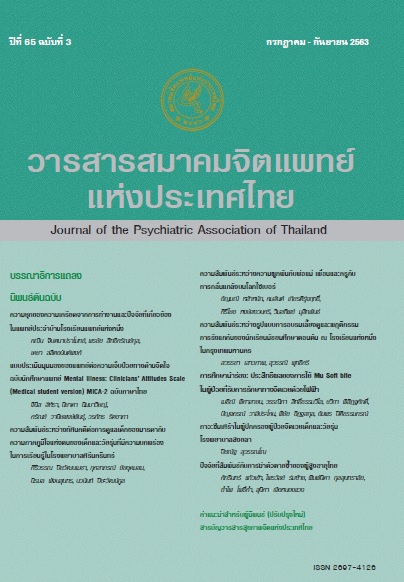Factors Associated with Re-Attempted Suicide within 1-Year Among Thai Elderly
Main Article Content
Abstract
Objective: To study factors associated with re- attempted suicide within 1 year amongThai elderly.
Method: The matching case- control study was conducted. The subjects were recruited Thai elderly with attempted suicide and registered in the 506S system during 2017. Cases were selected 41 re- attempted suicide while 103 controls were matched by gender, age and domicile which divided into 2 groups consisting of 56 single attempted suicide and 47 never attempted suicide. Instruments were used the structured interview questionnaire consisting of demographic data, screening for cognitive function, alcohol and substance use, anxiety and depression, activities of daily living, pain, social support, domestic violence, health care accessibility. Data analysis used descriptive statistics and inferential statistics for risk and protective factors: Odds ratio (OR) with 95% CI with simple conditional logistic regression and conditional multiple logistic regression backward stepwise.
Result: Samples were predominantly female (63.8%), primary education (63.8%), presence of physical illnesses (63.8%),married (63.8%), unemployed (63.8%). Risk factors for re-attempted suicide within 1 year with statistically significant were depression [ OR = 2.96 (95% CI = 1.12-7.78)]and anxiety [OR = 4.15 (1.64-12.07)]. Protective factors with statistically significant were receiving treatment from alternative medicine [OR = 0.20 (95% CI = 0.05-0.88)], participation in social activities during traditional festival [OR = 0.33 (95% CI = 0.14-0.77)] and receiving emotional support [OR = 0.36, (95% CI = 0.16-0.38)].The conditional multiple logistic regression backward stepwise analysis revealed only depression was a predictor of re-attempted suicide among Thai elderly with pseudo R2 = 0.20
Conclusion: Significant factors associated with re-attempted suicide within 1-year among Thai elderly are depression, anxiety, receiving emotional support and participation in social activities. Therefore, mental health personnel should promote elderly to participate in social activities and screening for depression in elderly.
Key words: elderly, re-attempted suicide, depression
Article Details
Articles submitted for consideration must not have been previously published or accepted for publication in any other journal, and must not be under review by any other journal.
References
2. Innamoratietal. Inequalities in Suicide Rates in the European Union’s Elderly: Trends and Impact of Macro-Socioeconomic Factors Between 1980 and 2006.The Canadian Journal of Psychiatry.2010; 55(4):229-238.
3. ศูนย์ป้องกันการฆ่าตัวตายระดับชาติ. รายงานอัตราการฆ่าตัวตายของประเทศไทยแยกตามช่วงอายุ ประจำปี 2559(ออนไลน์). สืบค้นจาก : https://suicide.dmh.go.th/report/suicide/age.asp
4. Juurlink et al.Medical Illness and the Risk of Suicide in the Elderly.Arch Intern Med. 2004;164(11):1179-1184.
5. Murphy et al. Risk factors for repetition and suicide following self-harm in older adults: multicentre cohort study. The British Journal of Psychiatry. 2012; 200: 399–404.
6. Ojagbemi et al. Suicidal behaviour in old age - results from the Ibadan study of ageing. BMC Psychiatry. 2013; 13:80Published online 2013 Mar 13
7. Choi et al. Risk factors of suicide attempt among people with suicidal ideation in South Korea: a cross-sectional study. BMC Public Health.2017;17:579Published online 2017 June 15
8. Dong et al. Elder Self-neglect and Suicidal Ideation in an U.S. Chinese Aging Population: Findings From the PINE Study. J GerontolA Biol Sci Med Sci.2017; 72(1):76–81.
9. Li et al.Association of Self-Reported Discrimination and Suicide Ideation in Older Chinese Americans.Am J Geriatr Psychiatry. 2018; 26(1): 42–51.
10. มาโนช หล่อตระกูล. การฆ่าตัวตาย : การรักษาและป้องกัน.กรุงเทพฯ: บียอนด์เอนเทอร์ไพรซ์; 2553.
11. หวาน ศรีเรือนทอง และคณะ.ความเสี่ยงการฆ่าตัวตายของคนไทย:การสำรวจระดับชาติ.วารสารสมาคมจิตแพทย์แห่งประเทศไทย. 2554; 56(4): 413-424
12. นันทวัช สิทธิรักษ์.จิตเวช ศิริราช DSM-5.กรุงเทพฯ: ภาควิชาจิตเวชศาสตร์ คณะแพทย์ศาสตร์ศิริราชพยาบาล มหาวิทยาลัยมหิดล;2558
13. Beautrais et al. Suicide Prevention A review of evidence of risk and protective factors, and points of effective intervention. Wellington: Ministry of Health; 2005.
14. Rushing et al.The relationship of religious involvement indicators and social support to current and past suicidality among depressed older adults.Aging & mental health.2013;17(3):366-374
15. สถาบันเวชศาสตร์ผู้สูงอายุ. การประเมินเทคโนโลยีทางการแพทย์ เรื่องการเปรียบเทียบความสัมพันธ์แบบทดสอบสภาพสมองเสื่อมเบื้องต้น ฉบับภาษาไทย(MMSE-Thai) 2002และแบบทดสอบสมรรถภาพสมองไทย (Thai Mini-Mental State Examination; TMSE) ในการคัดกรองผู้สูงอายุภาวะสมองเสื่อม. กรุงเทพฯ:บริษัท ซีจีทูล จำกัด; 2551
16. สาวิตรี อัษณางค์กรชัย และนพพร ตันติรังสี.แบบคัดกรอง ASSIST ฉบับภาษาไทย.แผนงานวิชาการสารเสพติดชุมชน สำนักงานกองทุนสนับสนุนการสร้างเสริมสุขภาพ ,กรุงเทพฯ:2557
17. ธนา นิลชัยโกวิทย์และคณะ.การพัฒนาแบบสอบถาม Hospital Anxiety and Depression Scale ฉบับภาษาไทยในผู้ป่วยโรคมะเร็ง วารสารสมาคมจิตแพทย์แห่งประทศไทย.41(1);2539.18-30
18. Wongpakaran N, Wongpakaran T. Prevalence of major depressive disorders and suicide in long-term care facilities: a report from Northern Thailand. Psychogeriatrics. 2012; 12(1):11-17.
19. สุทธิชัย จิตะพันธ์กุลและคณะ. การวิเคราะห์ผู้สูงอายุ. หลักสำคัญของเวชศาสตร์ผู้สูงอายุ. โรงพิมพ์แห่งจุฬาลงกรณ์มหาวิทยาลัย;2541:85-6.
20. Mahoney FI, Barthel DW. Functional evaluation. The barthel index. Maryland State Med J. 1965:14;61-65
21. MuthitaPhanasathit.Validity and Reliability of Lawton Instrumental Activities of Daily Living Scale (L-IADL) and Older People's Quality of Life Questionnaire (OPQOL-Brief): Thai version.Available from:https://www.researchgate.net/project/Validity-and-Reliability-of-Lawton-Instrumental-Activities-of-Daily-Living-Scale-L-IADL-and-Older-Peoples-Quality-of-Life-Questionnaire-OPQOL-Brief-Thai-version
22. วสุวัฒน์ กิติสมประยูรกุล, จักกริช กล้าผจญ และ อภิชนา โฆวินทะ. แบบประเมินความเจ็บปวด Short –form McGill Pain Questionnaire ฉบับภาษาไทย. เวชศาสตร์ฟื้นฟูสาร.2547;14(3):83-92
23. ขวัญสุดา บุญทศ. การสนับสนุนทางสังคมต่อผู้ที่เป็นโรคจิตเภท, คณะพยาบาลศาสตร์ มหาวิทยาลัยขอนแก่นรายงานวิจัย. ขอนแก่น: 2554
24. ภัณฑิลา อิฐรัตน์, กฤตยา แสวงเจริญ, จิราวรรณ แท่นวัฒนากุล, นิลาวรรณ ฉันทะปรีดา และสมพร วัฒนนุกูลเกียรติ. ความรุนแรงในครอบครัวภาคตะวันออกเฉียงเหนือ, คณะพยาบาลศาสตร์ มหาวิทยาลัยขอนแก่นรายงานวิจัย. ขอนแก่น: 2545
25. Hyun-Jung Kwon et alSocial Relationships and Suicidal Ideation Among the Elderly Who Live Alone in Republic of Korea: A Logistic Model


